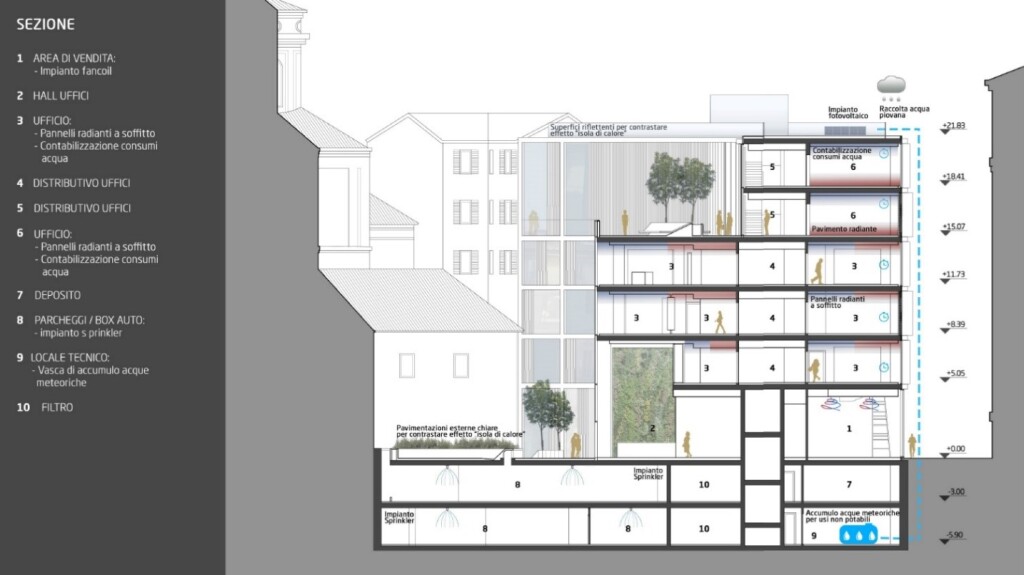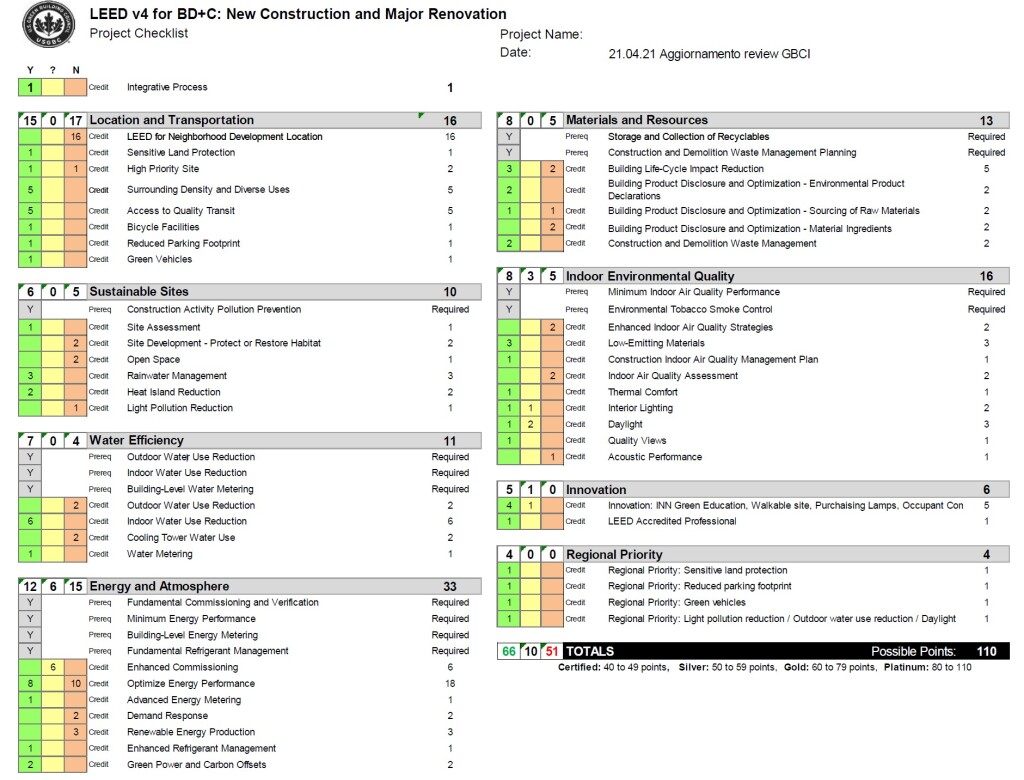AUTHOR: Federica Potenza
TUTORS: Pietro Giuseppe Crespi (Tutor Accademico), Daniele Beretta (Tutor Aziendale)
INTERNSHIP: United Consulting Srl
MASTER: Master in “Edifici e Infrastrutture Sostenibili” a.a 2020/21
Affrontando il tema della sostenibilità ambientale, un settore da valutare con la massima considerazione è senza dubbio quello edile, essendo noto che gli edifici sono oggi responsabili di circa la metà dei consumi totali di energia a livello mondiale, responsabile dell’emissione di circa il 36% di gas serra e del consumo del 40% di energia, 50% di materie prime estratte, 21% dell’acqua, rappresentando un grande nemico nel raggiungimento degli obiettivi di contrasto al cambiamento climatico.
Il protocollo Leed (Leadership in Energy and Environmental Design), è uno fra i più diffusi e riconosciuti sistemi di rating a livello internazionale che, raccogliendo gli standard di misura necessari a valutare la sostenibilità delle nuove costruzioni, e rispettando gli adempimenti previsti dai CAM (Criteri Minimi Ambientali) resi obbligatori dall’art. 18 della L. 221/2015 e, successivamente, dall’art. 34 recante “Criteri di sostenibilità energetica e ambientale” del D.Lgs. 50/2016 “Codice degli appalti” (modificato dal D.Lgs 56/2017), costituisce uno strumento idoneo a migliorare la cultura edilizia in modo che sia sempre più sostenibile e green.
Secondo questo protocollo risultano sostenibili quei modelli innovativi di progettazione e costruzione che affrontino in modo integrato sia gli aspetti architettonici, impiantistici e funzionali dell’edificio, sia gli aspetti relativi alle caratteristiche del sito, al consumo delle risorse naturali, all’inquinamento dell’ambiente, alla gestione dei rifiuti, alla durabilità e al riciclo dei materiali, alla qualità e salubrità degli ambienti.
Nella tesi in esame sarà sottoposto a tale sistema di rating il progetto di riqualificazione di un complesso edilizio direzionale di un Ente Istituzionale situato nel centro storico di Milano.
L’involucro edilizio e le componenti del sistema edificio-impianto sono stati studiati al fine di conseguire la certificazione LEED v4 “Building Design and Construction: New Construction and Major Renovation” dell’immobile ad un livello GOLD. Questo consente, allo stesso tempo, il rispetto degli adempimenti CAM Edilizia, insiti nell’obbligo di rispetto dei relativi parametri previsti dal nuovo codice degli appalti pubblici. Nella tesi verrà quindi analizzato il percorso per l’ottenimento di tale certificazione tramite una preliminare valutazione della sostenibilità dell’intervento (Pre-assessment).
Inoltre all’intervento di ristrutturazione edilizia sarà applicato il documento tecnico per l’attuazione della disciplina di cui all’Art. 10 “Sostenibilità ambientale e resilienza urbana” delle Norme d’attuazione del Piano delle Regole del PGT, utilizzando i fogli di calcolo per la verifica delle prestazioni richieste.
Uno studio che metterà in mostra, confermando le più recenti ricerche, quanto la progettazione realizzata secondo i sistemi di rating produce ambienti interni in grado di migliorare sensibilmente la produttività del principale asset di un’impresa, i propri lavoratori, agendo anche sulla salute e benessere, con conseguenti benefici del business. Il tutto nella speranza che alla considerazione che già faceva nell’800 Henry David Thoreau: “A che serve possedere una casa se non hai un pianeta dove metterla?” possa darsi finalmente risposta.
FOR INTERNATIONAL STUDENTS:
Dealing with the theme of environmental sustainability, one sector to be evaluated with the utmost consideration is undoubtedly the building construction, since it is known that buildings are now responsible for about half of total energy consumption worldwide, responsible for the emission of about 36% of greenhouse gases and the consumption of 40% of energy, 50% of raw materials extracted, 21% of water, so that they represent a great enemy in the achievement of objectives to combat climate change.
The LEED (Leadership in Energy and Environmental Design) protocol is one of the most widespread and internationally accepted rating systems which, by collecting the measurement standards needed to assess the sustainability of new buildings, is a suitable tool to improve a building culture more and more sustainable and green, complying with the requirements of the CAM (Minimum Environmental Criteria) made compulsory by art. 18 of Law 221/2015 and, subsequently, by art. 34 on “Energy and environmental sustainability criteria” of Legislative Decree 50/2016 “Procurement Code” (amended by Legislative Decree 56/2017).
According to this protocol, innovative design and construction models are sustainable if they address in an integrated way both the architectural, plant and functional aspects of the building, as well as the aspects relating to the characteristics of the site, the consumption of natural resources, the environmental pollution, the waste management, the durability and recycling of materials, the quality and healthiness of indoor environments.
In this thesis the redevelopment project of a public directional complex located in the historic center of Milan will be submitted to this rating system.
The building envelope and the components of the building-plant system have been studied in order to obtain the LEED v4 certification “Building Design and Construction: New Construction and Major Renovation” for a building at a GOLD level.
This allows, at the same time, the fulfilment of the CAM Building requirements, respecting the relative parameters foreseen by the new public procurement code. The thesis will therefore analyse the pathway to obtaining this certification through a preliminary assessment of the sustainability of the intervention (Pre-assessment).
In addition, the technical document for the implementation of the discipline of Art. 10 “Environmental Sustainability and Urban Resilience” of the Implementation Rules of the PGT Rules Plan, will be applied to the building renovation, using the spreadsheets for the verification of the required performance.
The study will show, confirming the most recent research, how much the design carried out, according to rating systems, produces indoor environments capable of improving the productivity of a company’s main asset, its workers, health and wellness, with consequent business benefits,
In hope that the consideration made by Henry David Thoreau in the 1800s, “What is the use of a house if you haven’t got a tolerable planet to put it on?” may be finally answered.


